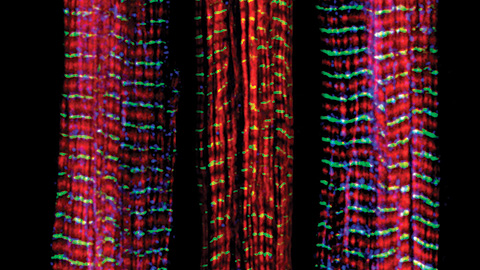
Living in a bubble
In our cells, proteins assemble into amazingly dynamic macromolecular machines whose function and regulation underlie life’s essential processes. A perfect example is gene expression, in which cells depend on versatile biomolecular machines to harness the information in DNA.
Understanding the inner workings of these intricate assemblies is among the great challenges in the biomedical sciences. Knowledge was, until recently, severely limited by their sizes and complexity.
Therefore, our field has been greatly excited by the incredible advances in cryo-electron microscopy and its “resolution revolution,” which we will feature in our symposia at the American Society for Biochemistry and Molecular Biology annual meeting, Discover BMB, in Seattle in March.
A contrast to the highly structured protein complexes lies in the often underappreciated structurally disordered protein regions, which also will be in in the limelight during our symposia. Recent studies have shown that, far from being useless, these disordered regions can cause liquid–liquid phase separation — an omnipresent phenomenon in eukaryotic cells underpinning the formation of membraneless organelles.
Localization of protein machines within membraneless organelles allows them to work more efficiently or achieve necessary regulatory interactions. Conversely, condensate disruption compromises the function of the protein machines within, leading to human diseases.
Keywords: Protein complexes, gene expression, genome maintenance, intrinsically disordered regions, lipid–lipid phase separation, computational biology, cancer, neurodegeneration.
Who should attend: Anyone who works with proteins with ordered or disordered regions. (Well, isn’t that everybody?)
Theme song: “With a Little Help from My Friends” by the Beatles. (The protein machines work so efficiently with the help of the condensates formed by disordered regions of the proteins.)
This session is powered by structured proteins (yang) and droplets (yin).
Speakers
Protein machines at the intersection of genome maintenance and gene regulation
Jessie Zhang (chair), University of Texas at Austin
Ivaylo Ivanov, Georgia State University
Huilin Li, Van Andel Institute
Tanya Paull, University of Texas at Austin
Yuan He, Northwestern University
Methodology investigating disordered proteins and condensates
Ivaylo Ivanov (chair), Georgia State University
Jeetain Mittal, Texas A&M University
Jessie Zhang, University of Texas at Austin
Xavier Darzacq, University of California, Berkeley
Simon Alterti, Technische Universität Dresden
Disordered protein in diseases
James Shorter, University of Pennsylvania
Hao Jiang, University of Virginia
Pinglong Xu, Zhejiang University
Rebecca Page (chair), University of Connecticut
The complete list
Learn about all 11 symposia planned for Discover BMB 2023:- Protein Machines and Disorder
- Regulation of RNA
- Organelles, Mechanisms and Phase Properties of Cellular Quality Control
- Lipid Dynamics and Signals in Membrane and Protein Structure
- Frontiers in Carbohydrate Synthesis and Recognition
- Bias In, Bias Out in Data Science
- Cell Signaling — New Tools and Emerging Concepts
- Education and Professional Development
- Biochemistry of Elemental Cycling
- Advances in Organismal and Cellular Metabolism
- Artificial Intelligence and Machine Learning in Structural Biology, Drug Design and Systems Biology
Enjoy reading ASBMB Today?
Become a member to receive the print edition four times a year and the digital edition monthly.
Learn moreGet the latest from ASBMB Today
Enter your email address, and we’ll send you a weekly email with recent articles, interviews and more.
Latest in Science
Science highlights or most popular articles

The science of staying strong
Muscles power every movement, but they also tell the story of aging itself. Scientists are uncovering how strength fades, why some species resist it and what lifestyle and molecular clues could help preserve muscle health for life.

Bacteriophage protein could make queso fresco safer
Researchers characterized the structure and function of PlyP100, a bacteriophage protein that shows promise as a food-safe antimicrobial for preventing Listeria monocytogenes growth in fresh cheeses.

Building the blueprint to block HIV
Wesley Sundquist will present his work on the HIV capsid and revolutionary drug, Lenacapavir, at the ASBMB Annual Meeting, March 7–10, in Maryland.

Gut microbes hijack cancer pathway in high-fat diets
Researchers at the Feinstein Institutes for Medical Research found that a high-fat diet increases ammonia-producing bacteria in the gut microbiome of mice, which in turn disrupts TGF-β signaling and promotes colorectal cancer.

Mapping fentanyl’s cellular footprint
Using a new imaging method, researchers at State University of New York at Buffalo traced fentanyl’s effects inside brain immune cells, revealing how the drug alters lipid droplets, pointing to new paths for addiction diagnostics.

Designing life’s building blocks with AI
Tanja Kortemme, a professor at the University of California, San Francisco, will discuss her research using computational biology to engineer proteins at the 2026 ASBMB Annual Meeting.


